“Unstuck her in time, day-sleeping in her bedroom. How old was she? Seven, seventeen, twenty-seven? Dusk or dawn? Couldn’t tell by the light outside. Checked her phone. Evening. The house silent, her mother probably asleep. Out through the smell of her grandfather’s fifty years of National Geographic, shelved in the hall.” — William Gibson, The Peripheral
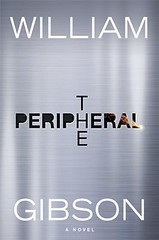 The Peripheral
The Peripheral
William Gibson
![]()
The Bridge Trilogy novels were my favorite works by William Gibson. The Peripheral has bumped them to second place.
I looked over my earlier Gibson reviews before writing this one and think this is worth repeating:
“Gibson likes complex stories with interrelated events and characters. He’s a student of pop culture, and his novels are right on top of current trends. Even more than complexity and hipness, I think, he likes happy endings. Some say he’s a sentimentalist, but I don’t think hipness has to be dark.”
There’s a strong strain of intellectual curiosity behind Gibson’s near-future stories, which always makes for good science fiction, but what I like best about his story-telling is that he leaves it to the reader to figure things out. He doesn’t explain. And when he does, usually through dialog between characters, it’s the barest minimum necessary, in context, and natural. In this novel, characters are immersed in what at first seem to be inexplicable events; it’s natural they would talk to one another and try to interpret what’s happening to them. We’re along for the ride with characters we can relate to and understand.
You can’t talk about what happens in The Peripheral without giving the store away. Most reviews try to explain the essential idea, so I will too. The novel centers around characters living in two futures: a near future and a more distant one, some 70-80 years beyond that. People in the farther future discover a way to communicate electronically with people in the earlier future; this has been made possible by some unspecified technological development occurring during that earlier future. Eventually, characters on both sides are able to virtually visit one another. Every interaction with the future changes the present, which branches off into “shunts.” In this novel, Gibson is concerned with characters living in one particular shunt. Well, enough of that. Gibson makes it real; I can’t even.
My favorite character in the Bridge Trilogy novels is Chevette. Chevette’s great-grandniece is Flynne, and I fell in love with her too. Brave, smart, unintimidated, rolling with the punches. And of all the little details Gibson creates to make the near future believable … a totally credible outgrowth of the world you and I live in now … Hefty Mart is the one that clicks. I’ll never pass the Costco snack bar again without thinking of Hefty Mart.
And what I said earlier about happy endings? Yes.
Seriously, I’m like a 14-year-old kid again, back in the Golden Age of science fiction. Gibson is sick, man! The Peripheral is astonishingly good.
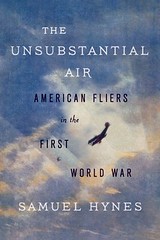 The Unsubstantial Air: American Fliers in the First World War
The Unsubstantial Air: American Fliers in the First World War
Samuel Hynes
![]()
I heard about this book from a friend and requested a copy from the library. It wasn’t yet in my local library system, but they found one for me (librarians are wonderful people) and I read it straight through.
I was a USAF fighter pilot from 1973 to 1997. Samuel Hynes flew fighters for the Marine Corps from 1943 to 1953. The Unsubstantial Air is about the first American fighter pilots, the young men who flew for England and France … and later on, the USA … during the Great War, between approximately 1916-1918. You can safely assume I was enthralled by Hynes’ book.
Using wartime diaries, letters, telegrams, newspaper articles, and personal recollections of surviving early aviators, Hynes traces the beginnings of young American men’s fascination with the idea of flying, the establishment of college flying clubs in the USA, and the early days of young American men heading off to England and France to play a role in the most important and romantic thing going in those days, the war in Europe. He follows the paths of the first volunteers, who generally started off as French Foreign Legionnaires or ambulance drivers and then gravitated to aviation. He recounts the beginnings of wartime flying training in the USA, the way young men with minimal flight training were transported to England and France, the building of training airfields overseas and the different ways men were taught to fly by the French and British. He follows key figures (Quentin Roosevelt, son of Teddy, for one; Billy Mitchell for another), who organized and oversaw American flight training in France in preparation for the USA’s eventual entry into the war.
All of this, and particularly the chapters describing actual combat over the front lines, is riveting reading, but what most fascinated me was discovering how little the essentials have changed. What attracted the first young men to flying in combat … the romantic idea of one-on-one combat, of being a knight of the air … is what attracts young men and women today. The desire to be above all things a chasse pilot (a pursuit pilot, or as we call them today, a fighter pilot, sent aloft to shoot down enemy aircraft), as opposed to a “mere” observation or bomber pilot … that too appears to be eternal.
No one knew how to conduct aerial combat in the beginning. They learned quickly: how to conduct aerial gunnery, how to strafe and bomb, how to provide mutual support to one another … the fundamentals every fighter pilot today must master. The life fighter pilots lived, the independence and spirited parties and drinking and whoring, the eagerness to take off at dawn to confront the Boche, the shock of a comrade’s sudden death … well, it’s the life Samuel Hynes lived in WWII and Korea; it’s the life I lived in F-15 squadrons during the Cold War and Desert Storm.
This really is a fabulous history of the beginnings of aviation and air power in wartime (as an aside, it’s taken us almost a hundred years, but the vision of air power pioneers like Billy Mitchell, which is powerfully spelled out in Hynes’ history, have finally become reality with improved aircraft, better command and control, and smart weapons). If you’re at all interested in military aviation, The Unsubstantial Air needs to be on your bookshelf.
 Lords of the Sky: How Fighter Pilots Changed War Forever, From the Red Baron to the F-16
Lords of the Sky: How Fighter Pilots Changed War Forever, From the Red Baron to the F-16
Dan Hampton
![]()
Hampton set out to write a comprehensive history of the fighter pilot, starting out strong with long, detailed sections on WWI and WWII. When I got to the Korean and Vietnam War sections, however, eras about which I have some knowledge, I began picking up on errors, omissions, and some oddly sloppy writing, the effect of which had me questioning what I had read in the WWI and WWII sections. By the time I got to the final chapters on the Gulf wars, I felt Hampton was doing a slapdash, rushed, incomplete job, and almost wish he’d stopped with WWII.
Among the errors: calling the piston-engined B-29 a “big jet,” mislabeling A-26s as B-26s, describing infrared heat-seeking missiles as homing in on hot carbon dioxide, saying the Navy initially called the F-4 Phantom II the F-110A Spectre (that was the early USAF designation, not the Navy’s). He doesn’t talk about the Russian MiG-15 pilots in Korea, a couple of whom scored more kills than our own top F-86 aces. He barely mentions the North Vietnamese MiG pilots. Describing the first shoot-down of a USAF fighter over North Vietnam, he switches between first-person and third-person viewpoints — one moment you’re in the cockpit with the pilot and GIB as they ingress the target area; then a god-like narrator, using passive voice, announces that one of the jets in the four-ship has been hit; then you’re back in the cockpit as the front-seater pulls the ejection handles.
While Hampton mentions some of the Soviet women fighter pilots of WWII, there’s not one word about today’s women, who’ve been flying fighters in and out of combat since the mid-1990s. He totally skips the eight-year Iraq/Iran war, which produced at least one Iranian F-14 ace. He doesn’t mention the air war in Kosovo or the years American and allied fighter pilots policed the no-fly zone imposed on Iraq after the first Gulf war. While he goes into detail on some of the methods used in command and control of airborne fighters, he unaccountably ignores AWACS. I expected him to at least mention some of the more notorious blue-on-blue friendly fire shootdowns, but he didn’t. He never brings up the battle between the strategic bombing and fighter factions for control of the USAF.
His only reference to the F-15 Eagle, a fighter aircraft of his own era (he himself flew F-16s), is a throwaway line referencing “some Eagles” participating in an air battle somewhere in the vicinity of a strike mission he flew in Iraq. That is not just a slight, it’s a gratuitous slight, and having flown the Eagle myself I took offense. Fighter pilots flying the F-15 Eagle have over the years achieved a perfect air-to-air kill ratio (105 to 0), something no other group of fighter pilots in the world has done, and one would think this feat would be mentioned in a book about fighter pilots.
The errors and omissions in the second half are jarring. The book seemed well-researched until the Korean War, then felt rushed and incomplete. I now think another book on fighter pilots — The Unsubstantial Air: American Fliers in the First World War, by Samuel Hynes, which I reviewed above — does a better job conveying the fighter pilot experience and mentality, and for two reasons. One, Hynes, unlike Hampton, spends more time explaining what fighter pilots believe in, how they think, and how they behave in the air and on the ground. Two, Hynes confines himself to a single era, WWI — now that may strike you as a limitation, but as an experienced fighter pilot myself I was struck by how little fighter pilots have changed from 1917 to the present day — and by keeping to one era, Hynes wasn’t forced to pick and choose what to include or exclude from his narrative.
Again, I think Hampton should have stopped with the end of WWII. To keep up with his book’s strong start, it should end there, and perhaps continue into the jet age in another volume entirely. Based on the strength of the first half of Hampton’s history, I’m giving his book an overall 3-star rating.
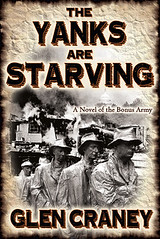 The Yanks Are Starving: A Novel of the Bonus Army
The Yanks Are Starving: A Novel of the Bonus Army
Glen Craney
![]()
Since the author asked me to read and review this book in exchange for a Kindle copy, I should explain my perhaps quirky star rating scale. Four stars, to me, is a top rating. Of all the 400+ books I’ve reviewed here on Goodreads, I’ve given just one five-star rating, that to the entire body of Aubrey/Maturin novels by Patrick O’Brian. So, three-and-a-half stars for this historical novel? That’s an excellent rating from me.
I thought The Yanks Are Starving a compelling read. I knew the bare outlines of the events the story is about, but none of the details; this fictionalized retelling of a now-forgotten episode in American history filled in that blank spot in my education. The characters in Craney’s story about the Bonus Expeditionary Force are, with few exceptions, historical figures who played important roles in the confrontation; the exceptions, as Craney explains in an afterward, are single characters meant to represent groups of participants (the nurse Anna standing in for several nurses; the black soldier Ozzie standing in for soldiers who fought in the Negro regiments).
I was fascinated to encounter young versions of historical characters I’ve studied in other contexts: Herbert Hoover, Douglas MacArthur, George S. Patton, Dwight Eisenhower. The author did his research; the characters come across as recognizable and real without being animatronic mannikins spouting quotes. At no point did I feel as if Craney were taking liberties with known history, as some historical novelists do.
As to the tales of what American soldiers did in the Great War and how the country turned its back to them during the Great Depression, open-minded students of actual American history … the un-sugarcoated version … will find plenty here to feed their cynicism. Politicians suck; the police serve their political masters; corruption is rampant; even the military leaders the down & out members of the Bonus Army once served want nothing to do with them. We treated our WWII veterans much better, but during my own life I’ve seen the country turn its back on other good soldiers … the veterans of the Korean and Vietnam wars, for example … but never to the shameful extent we abandoned the heroes of WWI at their time of greatest need.
And what excuse was used to justify putting down the Bonus Army in the streets of Washington DC with military force? Communist agitation, the all-purpose bogeyman I remember from the McCarthy days of the 1950s … I now better understand its origins and underpinnings. For that alone, Craney gets my respect.
The only bad marks I’d give this historical novel are a few typos and a couple of what I think, perhaps mistakenly so, are anachronisms: one a reference to Herbert Hoover as “leader of the free world” (was that description applied to any American president before WWII?); one reference to working in “Stalin’s gulags” (did we know about the gulags, or use that term even if we did, in the early 1930s?).
Trivial quibbles aside, I got a lot out of The Yanks Are Starving. It’s a compellingly interesting story.
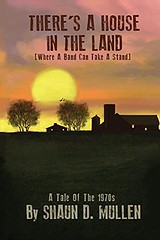 There’s a House in the Land: (Where a Band Can Take a Stand)
There’s a House in the Land: (Where a Band Can Take a Stand)
Shaun D. Mullen
![]()
Shaun Mullen offered me a Kindle copy of this book in exchange for a review. At the time I was reviewing another book at an author’s request and had two library books to finish before their due dates, so some weeks passed before I picked up There’s a House in the Land. Once I did, though, I didn’t put it down.
I purposely did not consult reader reviews first, and initially couldn’t put this book on a mental shelf. Was it a story? Was it a fictionalized version of post-Vietnam America? Was it a straight memoir? Soon enough it became clear to me Mullen’s book is a straight memoir … one of the straightest I’ve read.
By that I mean most memoirs have a unifying theme or story to tell. Writers arrange memories and incidents to say something larger than their retold memories and incidents would themselves convey. Not so here: Mullen simply recounts his experiences in the 1970s, when he lived on a farm in Pennsylvania with several men, women, children, and animals. A bit of a story bubbles through, but generally what Mullen give us is a series of snapshots of a period of time and a particular subculture that thrived then.
The memoir is divided into chapters, but I couldn’t discern a reason for chapter breaks. Within each chapter, however, are several mini-chapters, divided on the page by the small silhouette of a farmhouse: these make more sense, since one mini-chapter will be about the farm’s horse, the next about a freeloading sometime resident, the next about attempting to brew beer, and so on.
There’s a large cast of characters, human and animal. At times it’s hard to keep them all straight; then again the narrative covers something like a decade, with people and critters constantly coming and going … one actually has to admire Shaun Mullen’s memory for names and details.
When I say Shaun Mullen doesn’t arrange his memories to convey some larger point, that’s not to say he doesn’t make deliberate editorial decisions: although he talks about the farm’s residents’ consumption of beer and pot throughout the memoir, he doesn’t get around to taking about their consumption of hard drugs until the final chapters; when he finally acknowledges this darker side of life at Kiln Farm, the net effect is disturbing. Had he laid all this on me at the beginning, I might have been tempted to put the book down.
The book is full of cultural references, from Doonesbury to Grateful Dead concerts. Maybe too many for my taste; some of the references felt forced.
Overall, druggy revelations at the end excepted, I very much enjoyed the visit to this Doonsbury-esque near past. I always envied the men and women my age who were able to pull off this emphatically non-nine-to-five lifestyle, and I read most of There’s a House in the Land with a smile on my face. My objection to the lack of a theme or larger point is probably the result of my own limited imagination: my memoir will have a theme because I can’t imagine writing it any other way, so yay for Shaun Mullen, and thanks for the read!
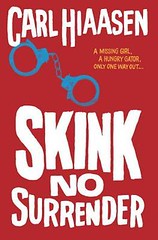 Skink–No Surrender (Skink #7)
Skink–No Surrender (Skink #7)
Carl Hiaasen
![]()
I notice a few reviewers expressing unhappiness with one of their favorite adult Hiaasen characters, Skink, appearing in a young adult Hiaasen story. Personally, I think YA is the perfect place for a character like Skink, a larger than life, semi-mythic, essentially comic character. I was happy to see Skink consorting with kids; Hiaasen and Skink have probably been heading in this direction all along.
I’ve read most of Hiaasen’s Florida novels, adult and YA, and have enjoyed them all. Skink–No Surrender is very much in line with Hiaasen’s earlier YA stories, filled with nature lore and detail, told from a decidedly pre-teen point of view (i.e., the kids aren’t thinking about sex yet), while still tolerably readable by adult Hiaasen fans.
I enjoyed Skink–No Surrender, but honestly it’s pretty lightweight reading for adult fans of Hiaasen’s fiction. What I wanted to do, after finishing this short novel, was to crack open one of Hiaasen’s earlier adult novels, Native Tongue or Skin Tight … or better yet re-read one of John D. MacDonald Travis McGee novels, which were probably Hiaasen’s inspiration in the first place.
Books I Didn’t Finish Reading
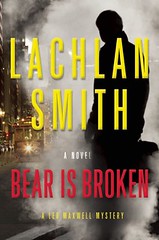 Bear is Broken
Bear is Broken
Lachlan Smith
![]()
I started thinking about reading something else a third of the way into this combo legal thriller & murder mystery, when, after a reasonably decent beginning, the author began to pad the plot with unrealistically-contrived complications. I plowed on out of loyalty to the friend who recommended Bear is Broken, but with a third of the book remaining I couldn’t go on; I was no longer interested in what might happen, either with the unsolved mystery or with the increasingly-annoying characters.